中国科技论文在线
http://www.paper.edu.cn
非齐次非线性 Schr¨odinger 方程爆破解的
L2-集中率
张健1,朱世辉1, 杨晗2
1 四川师范大学数学与软件科学学院,成都 610066
2 西南交通大学数学学院,成都 610031
摘要:本文研究临界幂非线性项的非齐次 Schr¨odinger 方程的爆破解. 利用对应基态变分特征,
我们得到爆破解的爆破速率以及爆破解的 L2-集中率.
关键词:非齐次 Schr¨odinger 方程; 爆破解; 爆破率; L2-集中率.
中图分类号: 175.26
Rate of L2-Concentration of Blow-up Solutions
for the Inhomogeneous Nonlinear Schr¨odinger
Equation
ZHANG Jian1, ZHU Shihui1 and YANG Han2
1College of Mathematics and Software Science, Sichuan Normal University
, Chengdu, 610066, China
2College of Mathematics, Southwest Jiaotong University,
Chengdu, 610031, China
Abstract: This paper is concerned with the blow-up solutions for inhomogeneous
Schr¨odinger equation with L2 critical nonlinearity. Using the variational characteristic of the
corresponding ground state, the blow-up rate and rate of L2-concentration of blow-up
solutions are obtained.
Key words: Inhomogeneous Schr¨odinger equation; Blow-up solution; Blow-up rate; Rate of
L2-concentration.
基金项目: Supported by National Natural Science Foundation of P.R.China (No. 11071177) and Research Fund for the
Doctoral Program of Higher Education of China (No. 20070636001)
作者简介: 张健(1964-),男,教授,主要研究方向:数学物理与偏微分方程。通信作者:朱世辉(1983-),男,讲师,主要
研究方向:偏微分方程。
- 1 -
�
中国科技论文在线
0 Introduction
http://www.paper.edu.cn
In this paper, we study the Cauchy problem of the following inhomogeneous Schr¨odinger
equation with L2 critical nonlinearity
iut + △u + jxjbjuj 2b+4
N u = 0; t 0; x 2 RN ;
(0.1)
∑
N
j=1
@2
@x2
j
u(0; x) = u0;
p1; △ =
(0.2)
is the Laplace operator in RN; u = u(t; x): [0; T ) RN ! C is
where i =
the complex valued function and 0 < T +1; N is the space dimension; the parameter b 0.
A few years ago, it was suggested that stable high power propagation can be achieved in plasma
by sending a preliminary laser beam that creates a channel with a reduced electron density,
and thus reduces the nonlinearity inside the channel(see[1, 2]). In this case, beam propagation
can be modeled by the inhomogeneous nonlinear Schr¨odinger equation in the following form
iϕt + △ϕ + K(x)jϕjp2ϕ = 0; ϕ(0; x) = φ 2 H 1(RN ):
(0.3)
Recently, this type of inhomogeneous nonlinear Schr¨odinger equations have been widely in-
vestigated. When k1 K(x) k2 with k1; k2 > 0 and p = 2 + 4
N , Merle[3] proved
the existence and nonexistence of blow-up solutions of the Cauchy problem (0.3). When
K(x) = K("jxj) 2 C 4(RN )
N , Fibich, Liu and Wang[2, 4, 5]
obtained the stability and instability of standing waves of the Cauchy problem (0.3).
(RN ) with " small and p = 2+ 4
∩
1
L
r = H 1
r (RN ), where H 1
For the Cauchy problem (0.1)-(0.2), Chen and Guo[6] showed the local well-posedness in
r (RN ) is the set of radially symmetric functions in H 1(RN ). Chen[7]
H 1
showed the sharp conditions of blow-up and global existence of the solutions. On the other
hand, in Equation (0.1), the nonlinearity is in the form jxjbjuj 2b+4
N u. Due to the unbounded
potential jxjb, to our knowledge, there are few results on the blow-up dynamical properties of
the blow-up solutions.
Motivated by the studies of the classical homogeneous nonlinear Schr¨odinger equation(see[8,
9, 10]), we consider the ground state solution of the Cauchy problem (0.1)-(0.2), which is a spe-
cial periodic solutions of Equation (0.1) in the form u(t; x) = ei!tQ(x), where ! 2 R and Q(x)
is called a ground state satisfying
△Q +
Q jxjbjQj 2b+4
N Q = 0; Q 2 H 1
r :
(0.4)
b + 2
N
In this paper, we call the solution of Equation (0.4) Q = Q(x) as the ground state solution of
Equation (0.4). Sintzoff and Willem[13] proved the existence of the ground state (0.4). Chen[7]
showed the following generalized Gagliardo-Nirenberg inequality: 8 f 2 H 1
r (RN ) and b 0
( ∥f∥L2
∥Q∥L2
) 2b+4
N ∥rf∥2
L2;
(0.5)
∫
jxjbjfj 2N +2b+4
N
dx 2N + 2b + 4
2N
- 2 -
�
中国科技论文在线
http://www.paper.edu.cn
where Q is the ground state solution of Equation (0.4). In the present paper, we firstly obtain
the lower bound of blow-up rate of the solutions to the Cauchy problem (0.1)-(0.2) by the
scaling invariance, as follows.
∥ru(t; x)∥L2 Kp
T t
as t ! T:
(0.6)
Moreover, we obtain the rate of L2-concentration of the radially symmetric blow-up solutions.
It reads that if u(t; x) is the radially symmetric blow-up solution of the Cauchy problem (0.1)-
∫
(0.2) in finite time 0 < T < +1, then, 8 " > 0, 9 K > 0 such that
∫
ju(t; x)j2dx (1 ")
jQj2dx;
(0.7)
lim
t!T
inf
jxjK
p
Tt
where Q is the ground state solution of Equation (0.4).
The major difficulties in studying the L2-concentration of the radially symmetric blow-up
solutions to the Cauchy problem (0.1)-(0.2) is that the nonlinearity containing a unbounded
potential jxjb. Firstly, Although our main arguments are from Merle and Tsutsumi[9, 10], we
need some new estimations to deal with the unbounded potential jxjb. Secondly, for the time
being, as we have mentioned, the results in the present paper are new for the Cauchy problem
(0.1)-(0.2) and the L2-concentration properties of the radially symmetric blow-up solutions have
definite meanings in physics. Finally, since b > 0, there is no space transformation invariance
for Equation (0.1) and the uniqueness of the ground state solution of Equation (0.4) is still
open. The L2-concentration properties of blow-up solutions to the Cauchy problem (0.1)-(0.2)
in the nonradial case is still unknown.
∫ dx respectively, and the various positive constants will be simply denoted by C.
In this paper, we denote Lq(RN ), ∥ ∥Lq(RN ), H 1
dx by Lq, ∥ ∥Lq, H 1
r (RN ) and
r and
∫
RN
1 Preliminary
For the Cauchy problem (0.1)-(0.2), the work space is defined by
2 + + x2
N ;
which is a Hilbert space. Moreover, we define the energy functional E(u) on H 1
r := fu 2 H 1j u(x) = u(r)g where r = jxj =
H 1
∫
1 + x2
x2
∫
r by
√
E(u) :=
1
2
jruj2dx
N
2N + 2b + 4
jxjbjuj 2N +2b+4
N
dx:
The functional E(u) is well-defined according to the Sobolev embedding theorem(see [8]). Chen
r , as follows.
and Guo[6] showed the local well-posedness for the Cauchy problem (0.1)-(0.2) in H 1
Proposition 1. (Chen and Guo[6]) Let N 3 and u0 2 H 1
r . There exists an unique solution
u(t; x) of the Cauchy problem (0.1)-(0.2) on the maximal time interval [0; T ) such that u(t; x) 2
- 3 -
�
(i)
(ii)
jxj N1
2
ju(x)j C(N )∥u∥ 1
L2∥ru∥ 1
L2:
2
2
(1.1)
(1.2)
(1.3)
(1.4)
(1.5)
(1.6)
中国科技论文在线
http://www.paper.edu.cn
r ) and either T = +1(global existence), or else T < +1 and lim
t!T
C([0; T ); H 1
(blow-up). Furthermore, for all t 2 [0; T ), u(t; x) satisfies the following conservation laws
(i) Conservation of mass
∥u(t; x)∥H 1
r
∫
∫
= +1
ju(t; x)j2dx =
ju0j2dx:
(ii) Conservation of energy
E(u(t; x)) = E(u0):
At the end of this section, we introduce two lemmas, which are important in studying the
radially symmetric functions.
Lemma 1. (Strauss[11]) Let N 2 and u(t) 2 H 1
have
r . Then, for any positive constant R, we
L1(jxj>R)
CR1N∥ru(t)∥L2(jxj>R)∥ u(t)∥L2(jxj>R):
Lemma 2. (Rother[12]) If N 3, 1 p < +1 and p = 2
C(N; c) > 0 such that for every u 2 D1;2
;ru 2 L2g,
+ 2c
N2, then there exists a
∥u(t)∥2
(∫
∫
jxjbjuj 2N +2b+4
N
) 2
∫
r (RN ) = fu 2 L2
p C(N; c)
jxjcjujpdx
( ∥u∥L2
dx 2N + 2b + 4
∥Q∥L2
2N
jruj2dx:
) 2b+4
N ∥ru∥2
L2;
r , then
Proposition 2. (Chen[7]) Let N 3 and 0 b < 2(N 1). If f 2 H 1
where Q is the ground state solution of Equation (0.4).
2 Rate of L2-Concentration
In this section, we first show the lower bound of blow-up rate of the solutions to the Cauchy
problem (0.1)-(0.2) by the scaling-invariant of Equation (0.1). Secondly, we obtain the rate of
L2-concentration of the radially symmetric blow-up solutions to the Cauchy problem (0.1)-(0.2)
by the generalized Gagliardo-Nirenberg inequality (1.6), as follows.
Theorem 1. Let N 3, 0 b < 2(N 1) and u0 2 H 1
u(t; x) 2 C([0; T ); H 1
in finite time 0 < T < +1.
r be radially symmetric. Assume that
r ) is the corresponding blow-up solution of the Cauchy problem (0.1)-(0.2)
- 4 -
�
中国科技论文在线
http://www.paper.edu.cn
(i)If a(t) is a decreasing function from [0; T ) to R+ such that
! 0;
and lim
t!T
p
T t
∫
a(t)
then
lim
t!T
a(t) ! 0
∫
lim
t!T
inf
jxja(t)
∫
(ii)For any " > 0,there exists a constant K > 0 such that
ju(t; x)2dx (1 ")
inf
jQj2dx;
lim
t!T
jxj 0 such that
∥ru(t; x)∥L2 Kp
T t
0 t < T:
;
(2.4)
Proof. Motivated by the study of classical nonlinear Schr¨odinger equation (see [15]), for
a fixed 0 t < T, one defines
t(s; x) =
N
2 (t)u(t + 2(t)s; (t)x)
(2.5)
with (t) =
1
∥ru∥
L2
. Note that t(s; x) is defined for
t + 2(t)s < T , s < Sc =
and for all s 2 [0; Sc), t(s; x) satisfies
T t
2(t)
;
s + △ t + jxjbj tj 2b+4
i t
N t = 0:
Moreover, since ∥ru∥L2 ! 0 as t ! T, one has
and
∥r t∥L2 ! +1; as s ! Sc;
∥ t(s = 0; x)∥L2 = ∥u(t)∥L2 = ∥u0∥L2:
By the definition of (t), one has
∥r t(s = 0; x)∥2
L2 = 2(t)∥ru(t)∥2
L2 = 1;
- 5 -
(2.6)
(2.7)
(2.8)
(2.9)
�
∥ t(s = 0; x)∥2
= ∥u0∥2
H 1
r
L2 + 1:
arguments (see[6]), for all c1 > 0, there exists a t1(c1) > 0 such that if ∥ t(s = 0; x)∥2
then there exists a c2 > 0 such that ∥ t(s; x)∥2
applying this statement with c1 = ∥u0∥2
(2.10)
On the other hand, by resolution of the Cauchy problem locally in time by fixed point
c1,
c2 in the interval t 2 [0; t1]. Therefore,
L2 + 1 (independent of t), one obtains that 8 t 2 [0; T )
T t
(2.11)
2(t)
= Sc t1;
H 1
r
H 1
r
which implies that
∥ru(t)∥2
This completes the proof of Proposition 3.2.
L2 t1
T t
:
Now, using the generalized Gagliardo-Nirenberg inequality (1.6), we have the following
proposition and Theorem 1 is a direct application.
Proposition 4. Let N 3, 0 b < 2(N 1) and u0 2 H 1
u(t; x) 2 C([0; T ); H 1
in finite time 0 < T < +1. Set (t) = ∥ru(t)∥L2. Then,
r be radially symmetric. Assume that
r ) is the corresponding blow-up solution of the Cauchy problem (0.1)-(0.2)
(i)If a(t) is a decreasing function from [0; T ) to R+ such that
! 0;
1
and lim
t!T
(t)a(t)
lim
t!T
a(t) ! 0
∫
inf
∫
then
lim
t!T
ju(t; x)j2dx
jxja(t)
(ii)For any " > 0,there exists a constant K > 0 such that
ju(t; x)2dx (1 ")
inf
jQj2dx;
lim
t!T
jxj< K
(t)
where Q is the ground state solution of Equation (0.4).
∫
jQj2dx;
∫
(2.12)
(2.13)
(2.14)
中国科技论文在线
which implies that
http://www.paper.edu.cn
Proof. (i) Let (x) = (jxj) 2 C
1
0 (RN ) be a radially symmetric function such that
{
(x) =
for jxj 1;
for jxj 2;
1
0
and 8 r > 0, one denotes r(x) = ( x
a(t) ),
(t) = ∥ru(t)∥L2 and a(t) = ∥rau(t)∥L2. Since the initial data u0 2 H 1
r , one has that the
corresponding solution u(t; x) is also radially symmetric according to the local well-posedness.
∫
r ). Using these notations, one takes a(x) = ( x
By the conservation of energy, one has
jruj2dx
jxjbjuj 2N +2b+4
jxjbjuj 2N +2b+4
dx =
∫
∫
N
N
N
N
2N + 2b + 4
jxja(t)
2N + 2b + 4
jxj>a(t)
1
2
dx+E(u0):
(2.15)
- 6 -
�
中国科技论文在线
http://www.paper.edu.cn
jxjbjauj 2N +2b+4
N
dx
∫
N
2N + 2b + 4
jxja(t)
a(t) = ∥r(au(t))∥2
2
L2
jxjbjuj 2N +2b+4
N
dx
(2.16)
Since
and
N
2N + 2b + 4
one has
∫
1
2
= ∥rau(t) + aru(t)∥2
( C
2(t) + C
a(t) (t) + C
∥u(t)∥L2 + ∥ru(t)∥L2)2
a(t)
L2
a2(t) ;
∫ jxjbjauj 2N +2b+4
N
N
2N +2b+4
dx
∫ jr(au)j2dx
∫
N
2N +2b+4
jxj>a(t)
∫
On the other hand, by Lemma 2 and the conservation of mass, one has
N
2N +2b+4
jxjbjuj 2N +2b+4
N
jxj>a(t)
dx =
N
2N +2b+4
dx + C
a(t) (t) + C
a2(t) + C:
N
jxjbjuj 2N +2b+4
∫
2b
ju(x)j)
L2 ∥u∥ 2N +2b+4
N1juj 2N +2b+4
2b
N1
L1(jxj>a(t))
2
N
N
2
N1
jxj>a(t)(jxj N1
∥ru∥ b
∥u∥ 2N +b+2
∥ru∥ b+2
L2 :
L2
N
N
N1 +2
L2
C∥u∥ b
2Nb2
C
N
C
2Nb2
N
(t)
(t)
∥ru∥ b+2
N
L2
(2.17)
(2.18)
2b
N1 dx
(2.19)
a
a
∫
One claims that, for 0 b < 2(N 1)
Indeed, since 0 b < 2(N 1), one has b+2
(1.6) that
∫ jruj2dx =
1
2
∫
2N +2b+4
N
∫ jxjbjauj 2N +2b+4
jxj
a(t)
lim
t!T
sup
N
dx
jxjbjuj 2N +2b+4
∥r(au)∥2
N < 2. It follows from the conservation laws and
(2.20)
= 0:
L2
jxjbjuj 2N +2b+4
N
dx +
N
2N +2b+4
jxjbjuj 2N +2b+4
N
dx + E(u0)
∫
jxj>a(t)
∥ru∥2
N
C
C∥au∥ 2b+4
C∥r(au)∥2
C∥r(au)∥2
dx +
C
(a(t)∥ru∥
L2 )
2Nb2
N
L2 + C
L2 ∥r(au)∥2
L2 +
C
(a(t)∥ru∥
L2 )
2Nb2
N
∥ru∥2
L2 + C
∥ru∥2
L2 + C
2Nb2
N
C
(a(t)(t))
L2 +
L2 + "∥ru∥2
L2 + C;
- 7 -
(2.21)
�中国科技论文在线
http://www.paper.edu.cn
2 and in the last step, one uses (2.12) and 0 b < 2(N 1). Therefore, one has
where 0 < " < 1
that 9K < +1 such that
lim
t!T
It follows from (2.19) and (2.22) that
∫
sup
∥ru∥2
∥r(au)∥2
L2
L2
= K:
jxj>a(t)
jxjbjuj 2N +2b+4
∥r(au)∥2
N
L2
dx
C(
∥ru∥
∥r(au)∥
L2
L2
) b+2
N
2Nb2
N
a
1
(t)∥r(au)∥2 b+2
N
L2
C
Since 0 b < 2(N 1), one has 2 b+2
1
2Nb2
:
N
(a(t)(t))
N > 0, which implies that Claim (2.20) is true for
Applying the generalized Gagliardo-Nirenberg inequality (1.6), it follows from (2.18) and
(2.22)
(2.23)
1
a(t)(t)
(2.20) that
! 0 as t ! T.
) 2b+4
(∥au∥L2
N
∥Q∥L2
[1
(∥au∥L2
∥Q∥L2
[1
jxj>a(t)
where Q is the ground state solution of Equation (0.4).
2N + 2b + 4
Therefore, by (2.22), one has
L2
2N
]∥r(au)∥2
∫
) 2b+4
N
] C
jxj>a(t)
∫
It follows from the Claim (2.12) and (2.20) that
a(t)a(t)
C
)
) 2b+4
N
0:
dx
+
N
jxjbjuj 2N +2b+4
2
a(t)
(
1
(∥au∥L2
∥Q∥L2
∫
lim
t!T
sup
+
C
a2(t)2
a(t)
+
C
2
a(t)
;
(2.24)
∫
jQj2dx;
(2.25)
lim
t!T
inf
jxj2a(t)
ju(t; x)j2dx lim
t!T
inf
jau(t; x)j2dx
Therefore, one has
∫
jxjbjuj 2N +2b+4
N
dx+
C
a(t)
(t)+
C
a2(t)
+C;
(ii) The proof is similar with (i). Taking a(t) = K
(t), where K is an arbitrary positive
which implies that (2.13) is true.
constant. By (2.24), one has
∥( (t)
[1
(
K x)u∥L2
∥Q∥L2
) 2b+4
N
] CK
2Nb2
N + CK
1 + CK
2:
(2.26)
Taking K sufficient large and letting t ! T in (2.26), one has that (2.14) is true.
At the end of this section, we shall give the proof of Theorem 1.
Proof of Theorem 1. By Proposition 3, one has that there exists a constant M > 0 such
- 8 -
�
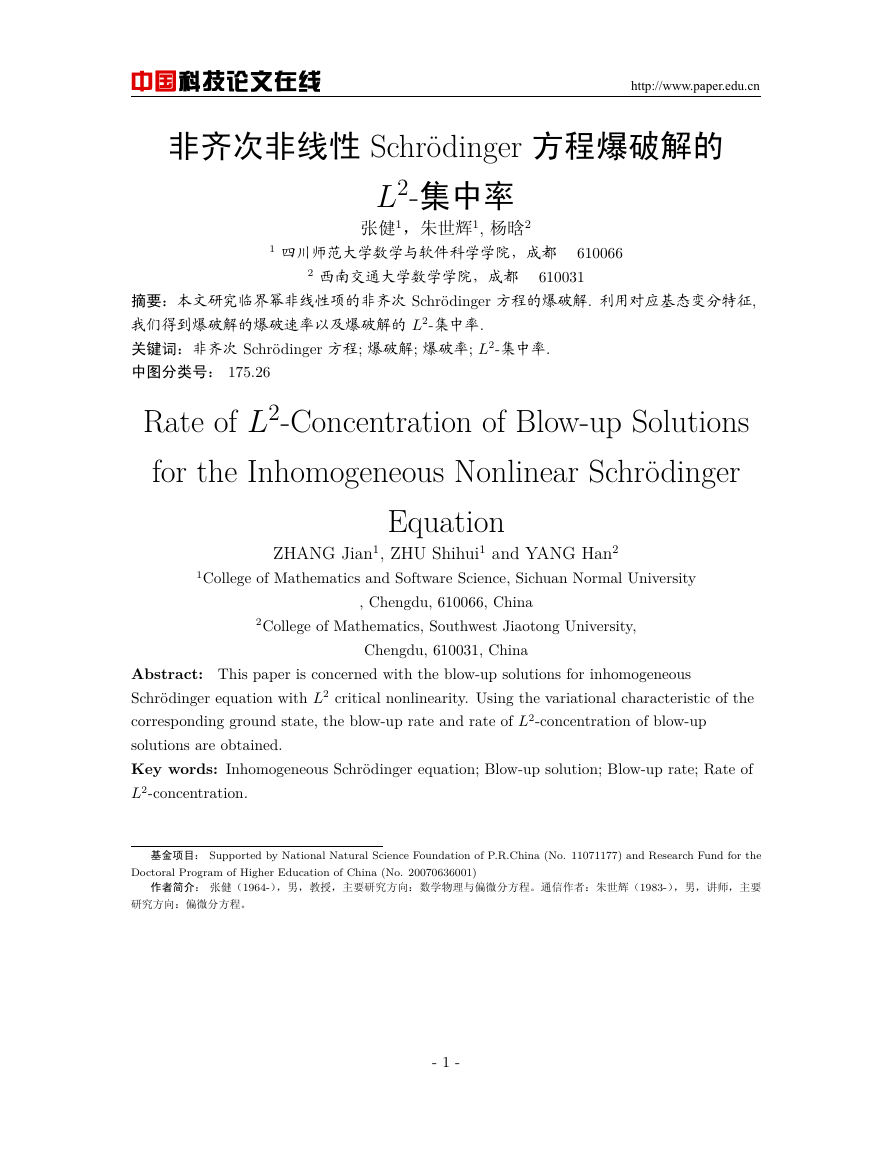

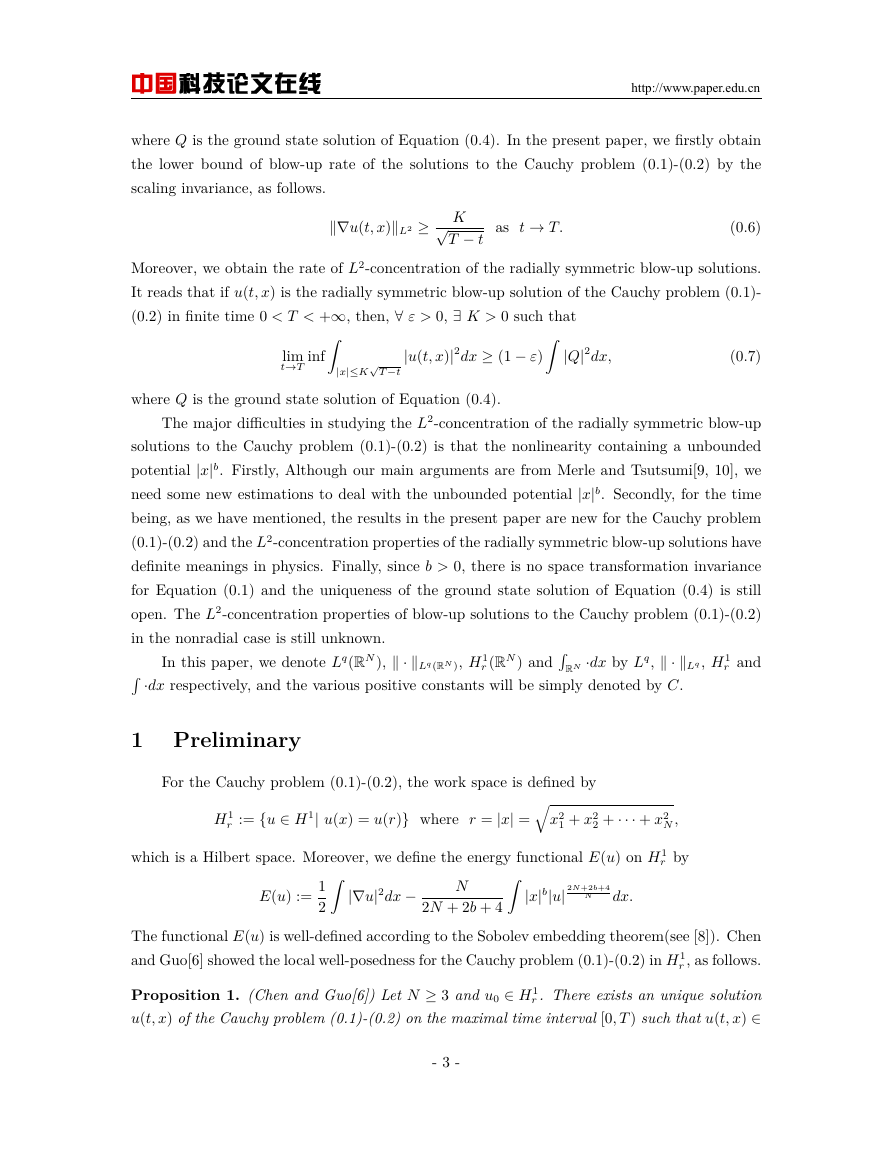
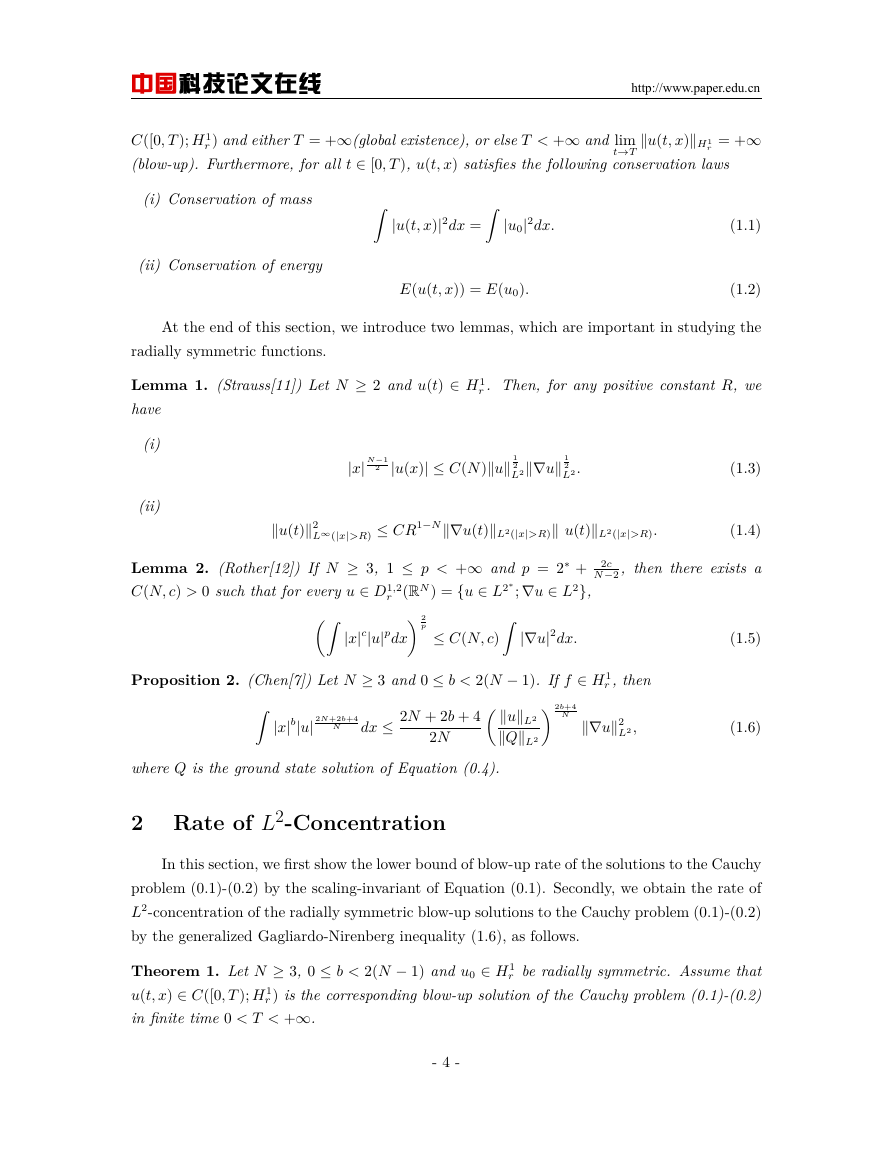
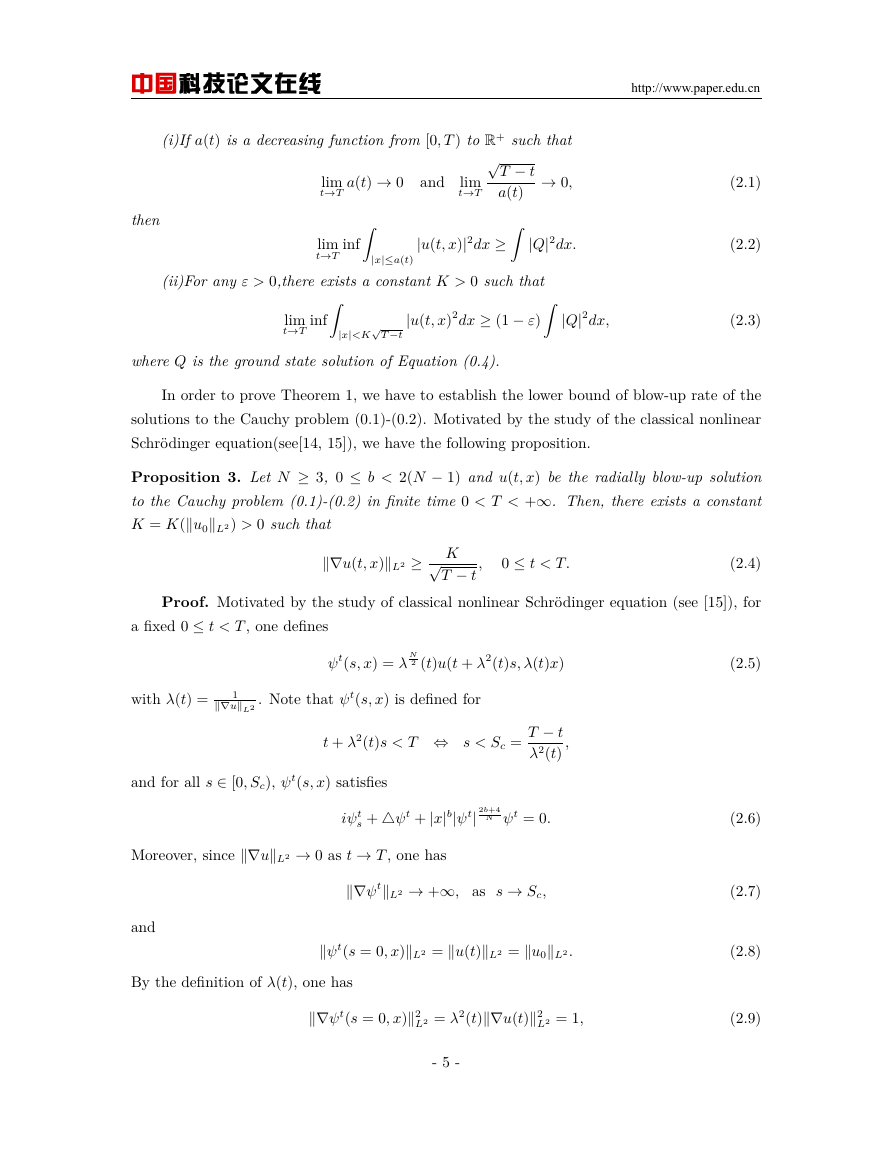
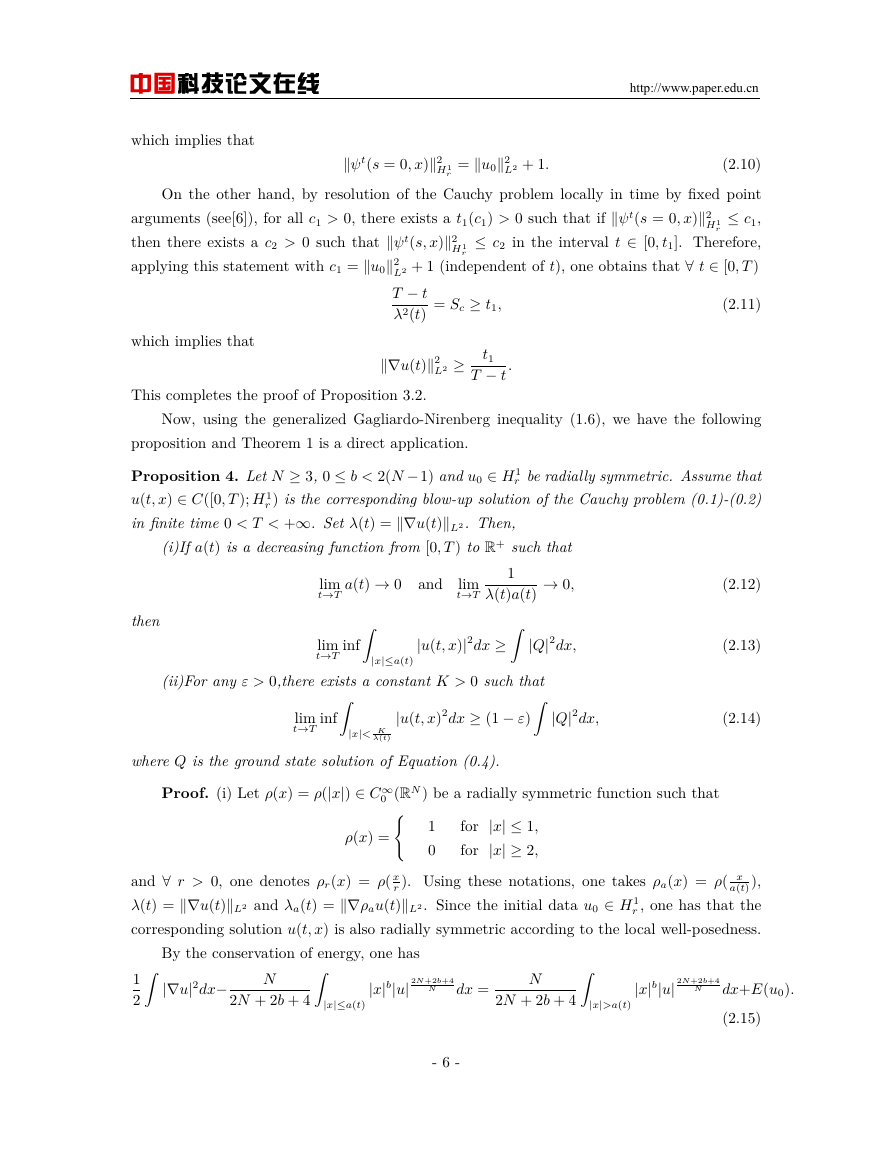
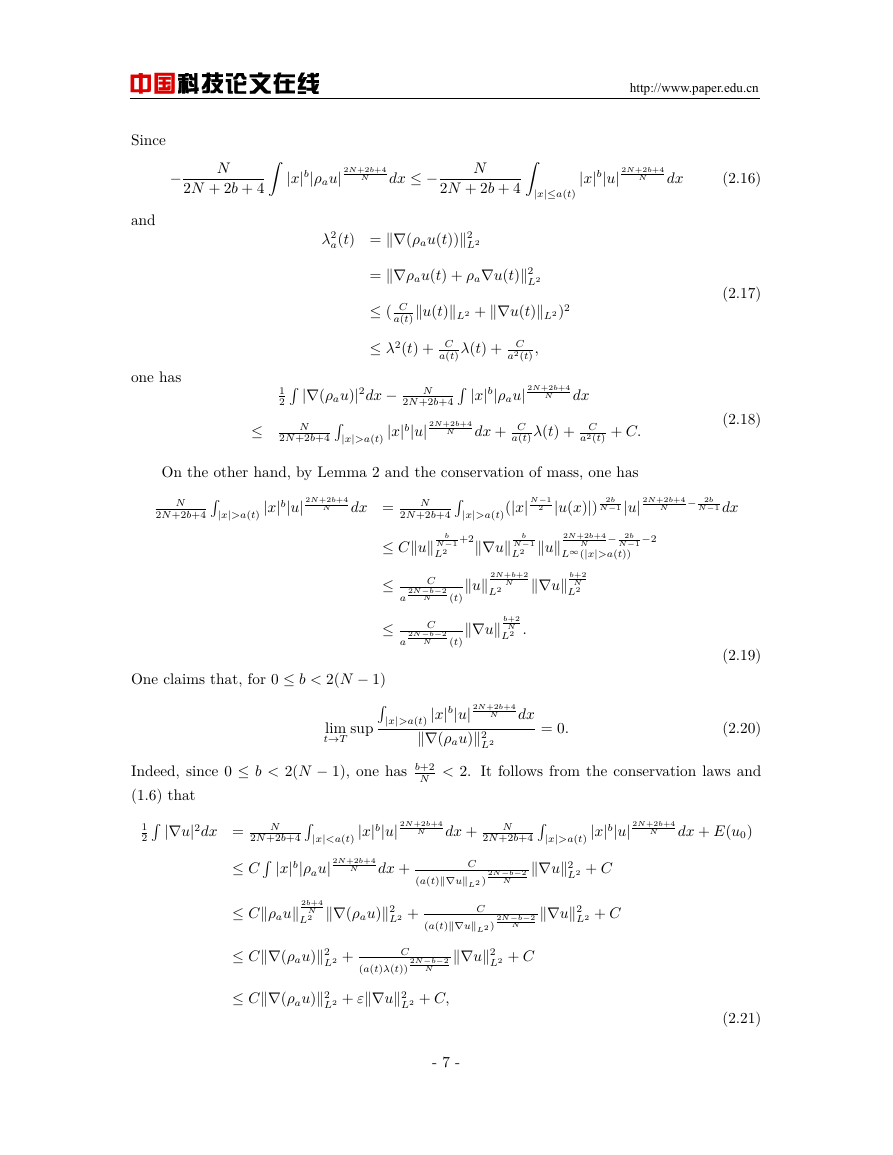









 2023年江西萍乡中考道德与法治真题及答案.doc
2023年江西萍乡中考道德与法治真题及答案.doc 2012年重庆南川中考生物真题及答案.doc
2012年重庆南川中考生物真题及答案.doc 2013年江西师范大学地理学综合及文艺理论基础考研真题.doc
2013年江西师范大学地理学综合及文艺理论基础考研真题.doc 2020年四川甘孜小升初语文真题及答案I卷.doc
2020年四川甘孜小升初语文真题及答案I卷.doc 2020年注册岩土工程师专业基础考试真题及答案.doc
2020年注册岩土工程师专业基础考试真题及答案.doc 2023-2024学年福建省厦门市九年级上学期数学月考试题及答案.doc
2023-2024学年福建省厦门市九年级上学期数学月考试题及答案.doc 2021-2022学年辽宁省沈阳市大东区九年级上学期语文期末试题及答案.doc
2021-2022学年辽宁省沈阳市大东区九年级上学期语文期末试题及答案.doc 2022-2023学年北京东城区初三第一学期物理期末试卷及答案.doc
2022-2023学年北京东城区初三第一学期物理期末试卷及答案.doc 2018上半年江西教师资格初中地理学科知识与教学能力真题及答案.doc
2018上半年江西教师资格初中地理学科知识与教学能力真题及答案.doc 2012年河北国家公务员申论考试真题及答案-省级.doc
2012年河北国家公务员申论考试真题及答案-省级.doc 2020-2021学年江苏省扬州市江都区邵樊片九年级上学期数学第一次质量检测试题及答案.doc
2020-2021学年江苏省扬州市江都区邵樊片九年级上学期数学第一次质量检测试题及答案.doc 2022下半年黑龙江教师资格证中学综合素质真题及答案.doc
2022下半年黑龙江教师资格证中学综合素质真题及答案.doc